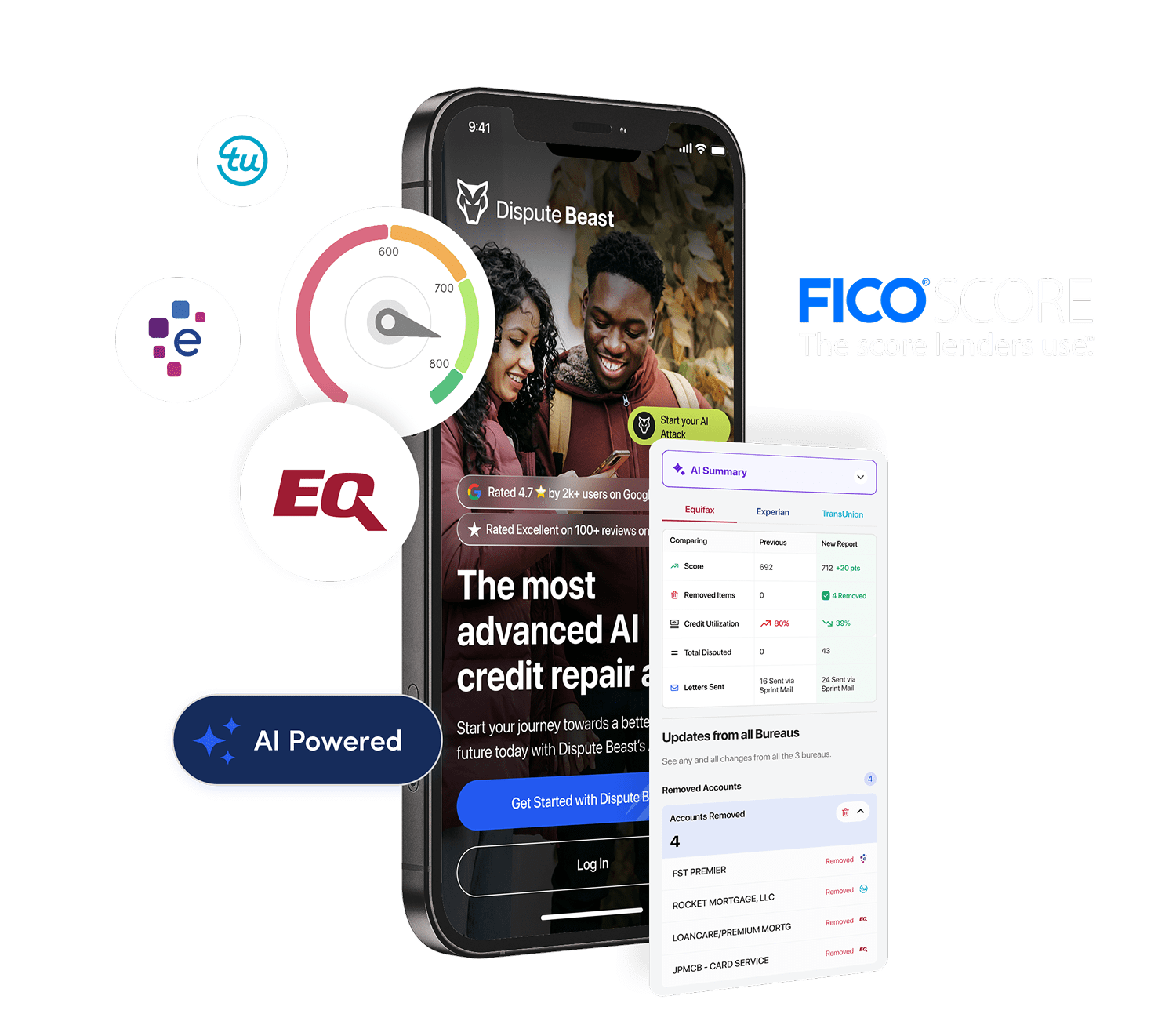Identity theft isn’t just a hassle—it can destroy your financial life if left untreated. When thieves open accounts in your name, rack up debts, or trigger collections, the damage to your credit score is real and lasting. But the good news is this: with the right steps, you can repair credit after identity theft and rebuild a strong financial foundation.
This guide gives you a complete roadmap for 2025, including how to spot fraudulent activity, how to dispute with bureaus and creditors, what legal protections you have, and how to strengthen your credit long-term. With identity theft at record highs, knowing how to respond is essential.
The Rising Threat of Identity Theft
Identity theft cases continue to climb. According to the Federal Trade Commission (FTC) there were over 1.1 million reports of identity theft in 2023, with credit card fraud being the most common form. Javelin Strategy & Research reported that victims of identity fraud lost nearly $20 billion in a single year.
These numbers underline why protecting and repairing your credit is more important than ever.
How Identity Theft Damages Your Credit
When someone steals your identity, the fallout shows up in several ways:
- Fraudulent credit card accounts opened in your name
- Unauthorized loans or payday advances
- Collections tied to debts you never incurred
- Skyrocketing credit utilization if fraudulent charges max out accounts
- Incorrect personal information, like new addresses linked to your file
- A flood of hard inquiries from fraudulent applications
Because payment history and utilization make up nearly 65% of your FICO Score, the effect is immediate. Even one fake account can drag your score down by 100+ points.
Step 1: Confirm the Fraud and Gather Evidence
Your first step is confirming identity theft. Signs include unfamiliar accounts on your credit report, bills arriving at your address for things you didn’t buy, or sudden drops in your credit score.
Checklist for gathering evidence:
- Copies of suspicious credit reports from Experian, Equifax, and TransUnion
- Letters, bills, or collection notices tied to fraudulent accounts
- Bank or credit card statements with unauthorized charges
- Police report or FTC Identity Theft Report (from IdentityTheft.gov)
Documenting everything early gives you leverage in disputes and ensures bureaus must take your claims seriously.
Step 2: File an FTC Identity Theft Report
The FTC provides a dedicated tool at IdentityTheft.gov. This generates an official Identity Theft Report you can use to prove fraud to creditors and bureaus. It also creates a personalized recovery plan. Filing this is free and protects your rights.
Step 3: Place Fraud Alerts and Consider a Credit Freeze
Fraud alerts require lenders to verify identity before opening new credit. Initial alerts last one year; extended alerts (with an FTC report) last seven years.
A credit freeze goes further. It locks your credit file so no one—including you—can open new accounts until you lift it. Freezes are available for free at all three bureaus: Experian Security Freeze, Equifax Freeze, and TransUnion Freeze.
Step 4: Dispute Fraudulent Accounts with Bureaus and Creditors
Once you have documentation, send disputes to each credit bureau. Highlight fraudulent accounts, incorrect balances, or addresses you don’t recognize. Under the Fair Credit Reporting Act (FCRA), bureaus must remove unverifiable or fraudulent data.
At the same time, contact creditors directly. Provide your FTC report and request they close fraudulent accounts, remove charges, and stop collections. Keep all communication in writing.
Inside Dispute Beast, you can run these disputes with one click, and track results in Beast Credit Monitoring (Vantage 3.0) or Pro Credit Watch (FICO 8) so you see progress with the same scores lenders use.
Step 5: Monitor Secondary Bureaus Too
Most victims focus on the “big three” bureaus. But identity theft often flows into secondary reporting agencies like LexisNexis, Innovis, or CoreLogic. If you don’t dispute there too, fraudulent data can reappear later.
Tools like Dispute Beast automate this process, sending compliance-based disputes to both primary and secondary bureaus to prevent reinsertion. This way, fraudulent data is blocked at every level and your reports stay clean across all platforms that lenders check.
Step 6: Protect Your Credit Score During Recovery
Repairing your score isn’t only about removing fraud—it’s about adding positive behavior. Strategies include:
- Opening a secured credit card and paying it in full monthly
- Getting a credit-builder loan from a credit union
- Keeping utilization below 10% on all revolving accounts
- Setting autopay to avoid new missed payments
- Using Experian Boost or similar tools to report on-time utility or phone bills
Step 7: Strengthen Digital Security
Identity theft doesn’t happen in a vacuum. Weak digital habits increase risk. Practical steps:
- Enable two-factor authentication on all financial accounts
- Use a password manager to create unique, strong passwords
- Monitor the dark web for your information with Have I Been Pwned
- Shred sensitive documents before disposal
- Be cautious about phishing emails or texts
Step 8: Understand How FICO and VantageScore Handle Fraud
Credit scoring models don’t treat fraud separately—they calculate based on data present. That’s why disputing fraudulent accounts quickly is key. Once removed, your score often rebounds fast.
According to FICO, payment history counts for 35% of your score, while utilization counts for 30%. These two areas are most impacted by identity theft, so repairing them drives faster recovery.
Step 9: Track Recovery Progress
Track your score month by month. Dispute cycles take 30–40 days, so improvements may show gradually. Document every bureau response, correction, or deletion. Create a calendar to plan follow-up disputes every 40 days until your report is clean. Dispute Beast makes this easy by automating the 40-day attack cycles, while you monitor improvements directly through Beast Credit Monitoring or Pro Credit Watch.
Step 10: Leverage Your Legal Rights
Your rights are backed by federal law:
- Fair Credit Reporting Act (FCRA)
- Fair Debt Collection Practices Act (FDCPA)
- Identity Theft and Assumption Deterrence Act
- Right to free credit reports after fraud at AnnualCreditReport.com
If bureaus or creditors fail to act, you can escalate complaints to the Consumer Financial Protection Bureau (CFPB).
Practical Recovery Timeline
- Month 1: File FTC report, freeze credit, send disputes, open secured card
- Month 2: Monitor responses, escalate non-removals, add credit-builder loan
- Month 3: Run second dispute cycle, track score improvements
- Month 4–6: Remove remaining fraud, maintain low utilization, build positive tradelines
- Month 6–12: Begin prequalification for loans with improved score
FAQs
Can I remove identity theft accounts early?
Yes. Fraudulent accounts are removed as soon as bureaus verify with your documentation—they don’t wait 7 years.
Will my score bounce back immediately?
Not instantly, but many victims see 60–100 point increases once fraudulent accounts are deleted.
Do I need a lawyer?
Usually not. Tools like Dispute Beast handle compliance-based disputes effectively. But if creditors refuse corrections, legal help may be needed.
Should I close all my accounts?
No. Close only fraudulent ones. Keep good-standing accounts open to preserve your credit age and history.
Conclusion: You Can Recover After Identity Theft
Identity theft can feel overwhelming, but it doesn’t define your financial future. With a structured plan—documenting fraud, filing with the FTC, freezing credit, disputing across all bureaus, and rebuilding with new positives—you can restore your credit score and your peace of mind.
Dispute Beast automates the hardest parts of the process, from generating compliance-based disputes to protecting against reinsertion from secondary bureaus. With the right tools and persistence, you can turn identity theft into a temporary setback instead of a permanent roadblock. Dispute Beast gives you automation, compliance-based disputes, and integrated monitoring through Beast Credit Monitoring (Vantage 3.0) or Pro Credit Watch (FICO 8). With lender-used FICO scores, enterprise-grade security, and hands-on support, you’re equipped to recover stronger than before.
👉 Start your recovery journey today with Dispute Beast and take back control of your credit in 2025.



